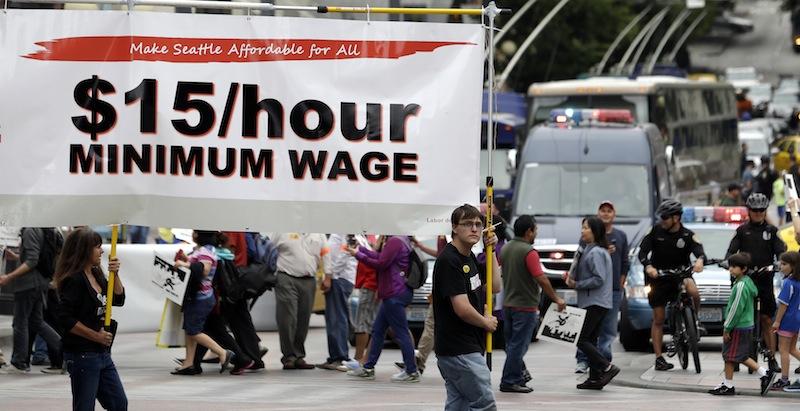Controversy Over $15 Hour Minimum Wage
In this photo taken, Aug. 1, 2013, demonstrators protesting what they say are low wages and improper treatment for fast-food workers march in downtown Seattle. In an interview with The Associated Press, Mayor Mike McGinn said he thought $15 was a “fair starting point” for the minimum wage discussion. McGinn challenger Ed Murray recently announced that he would push for a $15 minimum wage but planned to proceed with a phased-in approach. Washington already has the nation’s highest state minimum wage at $9.19 an hour. (AP Photo/Elaine Thompson, File)
April 26, 2016
Minimum wage has been in the discussion of many economists across the nation. New York and California have pressed similar efforts towards raising the statewide minimum wage to $15 an hour for employees statewide. Hundreds of low-wage workers have rallied across the nation in fight for a $15 minimum wage especially in the big cities of San Diego, Los Angeles, and New York City where wages are relatively lower than other parts of the state.
On April 4th 2016, Governor of California Jerry Brown signed legislation, committing to a minimum wage of $15 an hour by 2022, acting similarly to a bill signing in New York. This bill will increase the minimum wage in California every year by one dollar, currently being $10 an hour and reaching $15 an hour by 2022 for big businesses (businesses with 25 or more employees) and 2023 for smaller businesses (businesses than 25 employees). However, this bill still has to be approved by moderate lawmakers in the assembly and still gives governor Jerry Brown the choice to opt out if the economy falters. Following the Golden State, New York Governor Andrew Cuomo has set the state onto a path to a statewide minimum wage of $15 by 2021, beginning by increasing the wages of workers in the big city. Governor Andrew Cuomo’s path to a statewide fixed wage will bring six different hourly minimum wages in the state including one for fast-food workers in NYC, those fast-food workers in the rest of the state, one for other workers in the city who have at least 10 co-workers, one for those in smaller workplaces, one for non-fast-food workers in Nassau, Suffolk and Westchester Counties and one for that group in the rest of the state. Both of these states have taken a lead in the $15 minimum wage making this a big experiment and as well a concern for economists as to how employers will react.
California joined New York in becoming one of the first states to commit to increasing their minimum wage to $15 an hour, leaving many economists with different attitudes towards the rise in minimum wage. In California many have discussed that the rise to $15 an hour will have different effects since different areas of the Californian state have different average labor wages, inferring that low wage cities will have a greater impact. Many fear that raising the minimum wages will disrupt economies and communities, potentially leading to an increase in unemployment and decline in sales because of price increases. However, many low-wage workers have objected. Although agreeing with the potential downfalls of raising the minimum wage, workers have argued that the $15 an hour change will increase the standard of living and would as well have a positive effect on consumer spending, stating wage growth as one of the potential main catalysts for retail.
The change in minimum wage is concerned to have many significant effects on businesses in both New York and California. Some fast food operators see higher minimum wages as having major positive effects. More low income workers who get an increase in their wages additionally get a significant increase in their disposable income, booming business for many companies, lifting economic activity in their areas. Many economists believe the increase in wages for workers will greatly increase unemployment potentially causing businesses to close, however the raising of the minimum wage to $15 in both New York and California will be an experiment with unpredictable results.



